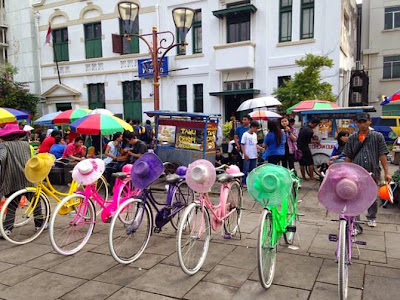Ages of tourist haven’t dampened
Bali's deeprooted spirituality and natural charms. Volcanoes rise from the beach, monkeys move within the trees, and you can still find a large number of idyllic places to escape the crowds. And this paradoxical magnificence all is crammed onto an island less than half the size of greater Tokyo.
But first time people to Bali might be forgiven if you are confused in what to anticipate. Images from Hollywood movies comparison with rumours that Bali is crowded with Australian tourists, risky to see and holiday brochures, and tragically over-developed – a complaint that may be accessed at a variety of global tourist locations. Find it yourself with this guide to finding your own personal little bit of paradise about the Gods' Island.
 |
| First-time Bali: where to eat, stay and play / bali rice field |
Kuta, Legian and Seminyak
Seminyak remains an epitome of class, Kuta still performs the wild child, and Legian falls between.
Must-dos contain sunset drinks at Potato Head Beach Club; conga lines and coconut drinks at Resort Mexicola (motelmexicola.com); haggling and people seeing on Kuta Beach; as well as a day of shopping and eating on Jl Laksmana, also known as Oberoi, Eat Block or Jl Kayu Aya. You will be hard-pressed to find a visitor around the area who hasn’t dropped into this lively precinct.
Larger Canggu
Many maps still course this location as ‘north Kuta’. But people will insist the expat-heavy enclave of Canggu has effectively and truly arrived. Larger Canggu, including Kerobokan, Umalas, Echo Beach, Berewa and Pererenan, has lured a creative and carefree crowd. You might find yourself manoeuvring a scooter between lost cattle on your way into a perfect macchiato at Crate Restaurant (a couple of kilometre back in the beach on Batu Bolong) or savouring vegetarian pad Thai at Green Ginger Noodle House.
Hotel here's less about upmarket chain hotels and more about specialist and unique, from upscale luxury villas like RedDoor
Bali to cheap and happy bungalow hideaways like United Colors of Bali. The area’s to do list has extended dramatically within the last decade, having a tenpin bowling alley, tennis courts, a water park, and trampoline centre within the Canggu Club precinct. Do not miss a visit to adjoining Tabanan’s Pura Tanah Lot temple that sits among crashing waves on an isolated rock.
Bukit Peninsula, Jimbaran Bay and Nusa Dua
The fist of land jutting out of southern Bali involves diverse tourist centers providing their particular versions of the dreamy day at the beach. The Bukit Peninsula offers up the world-famous dunes of Ulu Watu, surf-shack feelings of Bingin, and unfathomably clear waters of Pandang and Dreamland Padang. You could possibly understand one of the Rock Club at Ayana Resort, Ulu’s key attractions, overlooking Jimbaran Bay if you’ve been pawing through holiday brochures. This attractive area is available by an open air lift that's seldom with no sizeable sunset queue.
Tourists make for freshly barbecued seafood, but more adventurous individuals should exchange seafood warungs for Jimbaran Fish Market.
At Nusa Dua, things return back to excessive and stylish, with leading-of-the- brand golf courses, umpteen high tea options and five-star hotels aplenty.
Ubud and Central Bali
A haven for your creative, alternative and psychic, Ubud is where Bali’s heartbeat might be seen. Below, chakra cleansing classes, crystal shops, vegetarian restaurants and canvas artwork stores reign supreme.
A swanky visit to Ubud might add a stay at the indulgent Bidadari Escape as well as a night of palette -pleasuring at Locavore. An even more grass-roots experience can include experimental dance lessons at completely odd Michi Escape (michiretreat.com), and deep discussions over quinoa at Alchemy.
With perhaps the island’s best dive spots right off the shores of Amed and Candidasa, as well as the island’s highest point, Gunung (Mount) Agung, growing above them, east Bali is just a place of literal highs and lows.
Sanur blends the best of the laid-back lodging available within the south and fishing town sense of the east and the great food. Match your visit using the International Kite Festival to find out Sanur in full swing.
North Bali
In northern Bali, days begin with dolphin-watching excursions from Lovina in traditional outrigger canoes, followed by long afternoons swimming in the mossy air terjun (waterfalls) of Sekumpul, Gitgit and Sambangan. Be equipped for several stairs, but as a general principle, more stairs equal less crowds.
To get a screen into Bali’s past, move from the area of Singaraja, the main city of Bali during Dutch colonial times and, until the growth of the south, the interface of introduction for most visitors.
West Bali
Many travellers can’t look beyond West Bali as the entrance to excellent surf, blazing their way to Medewi or Java. Whilst, they are skirting the stunning Taman Taman Nasional Bali Barat (West Bali National Park) with its calm, private beaches that are home to categories of wild deer, and unique regional flavours like ayam betutu, a wood-smoked chicken broth served with grain and spicy spinach.
Despite the selling point of surreal coral cliffs and its fluorescent marine life, Menjangan Island offers among Bali’s least crowded dive areas, off the coast of west Bali. On the superior edge of west and north
Bali, the legendary rock fountain baths of Air Panas Banjar nod for the island’s strong religious roots.
Nusa Lembongan
Once the chaos of the mainland gets a lot of, Nusa Lembongan
Obyek Wisata di Bali is a 30-minute boat trip over the Badung Strait. Ignoring the existence of modern bars and the few new hotels, Lembongan's appeal is based on the authenticity of island life.
While away your days snorkelling, diving and surfing, experimenting with yoga moves over a stand up paddleboard, kayaking through mangrove forests, or finding a sense for that island’s seaweed farming industry. Walk the yellow suspension bridge to Nusa Ceningan where you can eat if that doesn’t keep you filled or sleep at the boat shed-style Le Pirate Beach Club.





